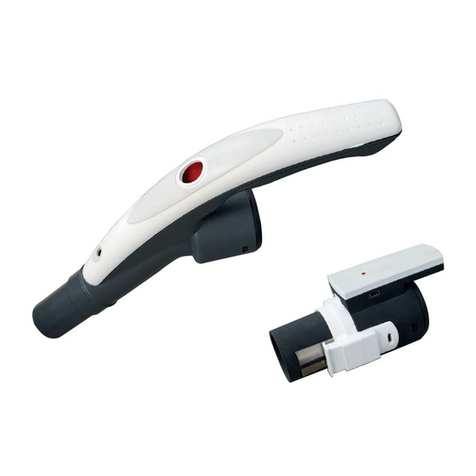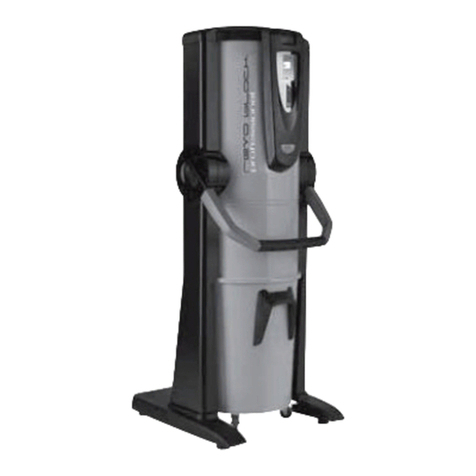NuTone VX3000C User manual

CENTRAL VACUUM SYSTEM
Broan Power Unit Models VX3000C, VX6000C, VX12000C
NuTone Power Unit Models VX475CC, VX550CC, VX1040CC
AB0004
INSTALLATION INSTRUCTIONS
30042319 rev. 09
SYSTEM PLANNING AND LAYOUT . . . . . . . . . . . . . . . . . . . . . . . . . . . . . . . 2-3
Examples . . . . . . . . . . . . . . . . . . . . . . . . . . . . . . . . . . . . . . . . . . . . . . . . 2-3
Locating the Power Unit . . . . . . . . . . . . . . . . . . . . . . . . . . . . . . . . . . . . . . 3
Tubing and Wall Inlet Locations . . . . . . . . . . . . . . . . . . . . . . . . . . . . . . . . 3
GENERAL INSTALLATION . . . . . . . . . . . . . . . . . . . . . . . . . . . . . . . . . . . . . . . 4
Tool Listing . . . . . . . . . . . . . . . . . . . . . . . . . . . . . . . . . . . . . . . . . . . . . . . . . 4
Working with Plastic Tubing . . . . . . . . . . . . . . . . . . . . . . . . . . . . . . . . . . . . 4
INSTALLATION IN NEW CONSTRUCTION . . . . . . . . . . . . . . . . . . . . . . . . . 5-6
Wall Inlet Rough-In . . . . . . . . . . . . . . . . . . . . . . . . . . . . . . . . . . . . . . . . . . 5
Installing the Tubing . . . . . . . . . . . . . . . . . . . . . . . . . . . . . . . . . . . . . . . . 5-6
Wall Inlet Installation . . . . . . . . . . . . . . . . . . . . . . . . . . . . . . . . . . . . . . . . . 6
INSTALLATION IN EXISTING CONSTRUCTION . . . . . . . . . . . . . . . . . . . . 7-11
Locating Access Keys in Existing Construction . . . . . . . . . . . . . . . . . . . . . 7
Avoiding In-Wall Obstacles . . . . . . . . . . . . . . . . . . . . . . . . . . . . . . . . . . . . 7
Inlet Tubing Installation . . . . . . . . . . . . . . . . . . . . . . . . . . . . . . . . . . . . . . 7-9
Wall Inlet Installation . . . . . . . . . . . . . . . . . . . . . . . . . . . . . . . . . . . . . . . 9-11
VACUSWEEP®INLET VALVE INSTALLATION . . . . . . . . . . . . . . . . . . . . 12-14
Connection From Below . . . . . . . . . . . . . . . . . . . . . . . . . . . . . . . . . . . . . .12
Connection From Behind . . . . . . . . . . . . . . . . . . . . . . . . . . . . . . . . . . . . .13
Connection In a Wall . . . . . . . . . . . . . . . . . . . . . . . . . . . . . . . . . . . . . .13-14
TUBING SYSTEM ASSEMBLY . . . . . . . . . . . . . . . . . . . . . . . . . . . . . . . . . 15-17
POWER UNIT INSTALLATION . . . . . . . . . . . . . . . . . . . . . . . . . . . . . . . . . 18-20
Mounting . . . . . . . . . . . . . . . . . . . . . . . . . . . . . . . . . . . . . . . . . . . . . . . . . 18
Tubing Connections at Power Unit . . . . . . . . . . . . . . . . . . . . . . . . . . . . . 19
Dimensional Chart . . . . . . . . . . . . . . . . . . . . . . . . . . . . . . . . . . . . . . . . . . 19
Wiring . . . . . . . . . . . . . . . . . . . . . . . . . . . . . . . . . . . . . . . . . . . . . . . . . 19-20
FINAL SYSTEM CHECK . . . . . . . . . . . . . . . . . . . . . . . . . . . . . . . . . . . . . . . . . 20
TROUBLESHOOTING GUIDE . . . . . . . . . . . . . . . . . . . . . . . . . . . . . . . . . . . . 21
WARRANTY . . . . . . . . . . . . . . . . . . . . . . . . . . . . . . . . . . . . . . . . . . . . . . . . . . 22
Broan-NuTone Canada Inc.; Mississauga, Ontario
www.broan.ca or www.nutone.ca 866-882-7626

THE RANCH STYLE HOUSE
Here the power unit is mounted in the
garage. The intake and exhaust tubing,
the only exposed tubing in the installation,
runs up the garage wall and into the attic.
The trunk line runs horizontally through
the attic from the power unit to the
farthest inlet location. Branch lines
spread throughout the attic, connecting
the trunk line to the inlet tubing. Each
inlet tube is threaded vertically through
an inside wall. Located in hallways and in
large rooms, the inlets are placed to
provide maximum access to all cleaning
areas. Refer to Figure 1.
THE SPLIT-LEVEL HOUSE
Like the two-story house, the split level
installation commonly calls for a two-level
trunk line. Here, the power unit is located
in the garage. The intake tubing runs
exposed up the garage wall and into the
ground level section's attic. Two branch
lines connect this part of the trunk line to
inlet lines which are dropped inside
interior walls. A vertical branch line runs
to the upstairs attic, where the trunk line
branches into a T-shape. This trunk line
connects to two upstairs inlet lines and to
one inlet line which drops through an
upstairs wall and down into the third-level
utility room to service this entire level.
Refer to Figure 2.
EXHAUST
TRUNK LINE
BRANCH LINE
INLETS
POWER
UNIT INTAKE
INLET LINE
AH0003A
FIGURE 1
EXHAUST
POWER
UNIT
INTAKE
TRUNK
LINE
VERTICAL
BRANCH
LINE
BRANCH
LINES
INLET
LINE
INLET
INLET
BRANCH
LINE
AH0004A
FIGURE 2
page 2
SYSTEM PLANNING LAYOUT
Central Vacuum Systems consist of a Power Unit, PVC Tubing and Fittings, Wall Inlets, a flexible Hose and various cleaning
accessories.
The Power Unit is designed to be wall-mounted away from the living area of the home and connected to the living area by means
of permanently installed in-wall tubing, fittings and inlets.
Generally, an installation will require 3 to 4 inlets and 16 to 20 feet (4.9 m to 6.1 m) of tubing per inlet. It is suggested that a floor
plan be used to more accurately determine the quantity of materials needed.
Use the following examples as an aid in planning the installation in either new or existing construction. You should be able to
adapt the examples shown to your specific home layout.
WARNING
!
When applicable local regulations comprise more restrictive installation and/or certification requirements,
the aforementioned requirements prevail on those of this document and the installer agrees to conform to
these at his own expenses.

SYSTEM PLANNING LAYOUT (CONT’D)
page 3
THE TWO-STORY HOUSE
A double-trunk line system is commonly
used in two-story houses. In the installation
shown at right, the power unit is mounted
in the basement. The intake tubing runs
up the basement wall and connects to the
main trunk line, which runs along the
unfinished basement ceiling. Two first-floor
inlets are connected to the basement
trunk line by vertical inlet lines run
through interior walls. In the center of the
house, a vertical branch line runs from
the basement trunk line, through stacked
closets, up into the attic. A second trunk
line runs across the attic and two branch
lines connect to inlet lines which are
dropped down through upstairs interior
walls. Refer to Figure 3.
VERTICAL
BRANCH
LINE
ATTIC
TRUNK
LINE
INLET
LINE
INLET
EXHAUST
INTAKE
POWER
UNIT
BASEMENT
TRUNK LINE
AH0005A
FIGURE 3
LOCATING THE POWER UNIT
● Locate the power unit at the lowest possible position away
from the general living area in an accessible location for
emptying the debris pail.
● When planning, remember the power unit is equipped
with an inlet to service a garage, basement, utility room,
etc., wherever it is located.
● Locate the power unit within 6 feet (1.82 m) of a grounded
electrical outlet. Broan models VX3000C and VX6000C
and NuTone models VX475CC & VX550CC power units
require a 120 V, 15-amp dedicated branch circuit with a
NEMA 5-15R receptacle or 20-amp dedicated branch
circuit with a NEMA 5-20R receptacle. Broan model
VX12000C and NuTone model VX1040CC power units
require a 240 V AC, 20-amp dedicated branch circuit with
a NEMA 6-20 receptacle.
● Do not locate the power unit close to a source of extreme
heat (e.g.: water heater) or in an area with a high ambient
temperature (e.g.: attic, furnace room).
● If the power unit is located in a closet or a small
utility room, make sure the area is well-ventilated (e.g.:
with door louvers).
● Exhausting the power unit to the outside is recommended
for optimal performance. The exhaust should not be vented
into a wall, a ceiling or a concealed space in the house.
The exhaust line should be vented outside the home
using a Model V142 wall cap.
TUBING AND WALL INLET LOCATIONS
1. Locate inlets on interior walls, choosing central
locations which allow several rooms to be cleaned from a
single inlet using a minimum 30-feet (9.1 m) long hose.
2. The tubing installation should consist of a main trunk
line running from the farthest wall inlet to the power
unit location, with branch lines running to each additional
inlet. Keep all tubing lines as straight as possible and use
as few fittings as possible.
3. Beginning at the area farthest from the power unit, choose
a tentative inlet location. Measure 30 feet (9.1 m) from the
proposed inlet location to the farthest corner of the rooms
to be cleaned by that inlet to determine if inlet location is
proper. If working from blueprints (or building plans drawn
at 1/4" [0.64 cm] = 1 ft [30.48 cm] scale), use a 7½" chain
as your guide to determine inlet locations.
4. Locate inlets within six feet (1.8 m) of an electrical
receptacle to allow use of optional current-carrying hose.
5. Be sure inlets will not be blocked by doors or furniture.
6. Be sure inlets will not interfere with electrical, plumbing or
other mechanical installations.
7. Move tentative inlet location if necessary. Use the same
procedure to determine each additional inlet location,
always working toward the power unit.

GENERAL INSTALLATION
TOOL LISTING
Depending on your installation, you may require the use of
these tools. The power tools are recommended to make your
installation proceed quickly. Also, plan a mask when cutting
ducting (PVC dust) and gloves when using glue.
• Wire Strippers • 1/4’’ Drill Bit
• Utility Knife • 1/2’’ Drill Bit
• Knife • Putty Knife
• 2½’’ Hole Saw • Keyhole Saw
• Hammer • Cold Chisel
• Level • Flashlight
• Drill • Electrical Tape
• Screwdriver • Safety Glasses
• Wrench • Hacksaw
• Tape Measure
WORKING WITH PLASTIC TUBING
Cutting Tubing
Before you cut a length of tube, accurately measure the
length you need. Allow 5/8” (16 mm) of tubing for inserting
into fittings and 1½” (38 mm) for placing into flexible tubing.
Cut the plastic tubing
with a hacksaw, making
sure that the cut is exactly
square. (You can use a
tube cutter if one is
available.) Use wire cutters
or tin snips to cut flexible
tubing, 8” (203 mm)
lengths of flexible tubing
should not be cut. Refer
to Figure 4.
Use a small knife to
remove any burrs from
the inside of the tube.
You can also use steel
wool to remove burrs.
The burrs must be
removed or they may
impede air flow of form
clogs by snagging hair
and carpet thread.
See Figure 5.
Next, use a file to slightly
bevel the outside of the
tube so that it will easily
slide into the fitting. Use
steel wool or a light
grained sandpaper to
buff the surface of the
tube which will be glued.
This will clean the tube
and assure a good seal.
Refer to Figure 6.
Making a Joint
Insert the tube into the
fitting, aligning the two
parts as they will be
installed. Mark the tube
and the fitting so that you
can quickly realign the
joint. Refer to Figure 7.
Apply cement only to the
outside of the tube. Dab
the cement generously in
an inch-wide (25 mm)
band. Insert the tube into
the fitting with the
alignment marks a quarter
turn apart, and then
quickly push and turn the
fitting to align the marks
and spread the cement.
Allow one minute for the
joint to dry. You may also
use electrical tape or duct
tape to further seal the
joint. Refer to Figure 8.
Cementing Flexible Tubing
Make sure the ends of the flexible tubing are even—trim if
necessary. When you join flexible tubing to plastic tubing or
to an inlet mounting plate, apply cement to both the inside of
the flexible tubing and the outside of the plastic tubing or
mounting plate tubing ring. Twist the two pieces as you join
them to evenly spread the glue. Allow five minutes for the
cement to set in flexible tubing. You may also use electrical
tape or duct tape to further seal the joint.
Secure Wire to Tubing
The low-voltage power
wiring is run along with
the tubing. To insure that
the wire is secure and will
not hang-up in a wall, use
electrical tape to attach
the wire to the tubing. Tape
the wire approximately
every 12-18 inches
(305 mm - 457 mm).
Refer to Figure 9.
AR0016
FIGURE 4
AR0017
AR0018
page 4
AR0019
AO0010
AO0011
MAKE SURE
CUT IS
STRAIGHT
FIGURE 5
FIGURE 6
FIGURE 9
FIGURE 7
FIGURE 8
When performing installation, servicing or
cleaning the unit, it is recommended to wear
safety glasses and gloves.
WARNING
!

MODEL V144 WALL INLET MOUNTING PLATE
(For use with V111 Series inlets)
Once the locations for wall inlets have been determined,
mount all inlet brackets.
1. To locate bracket on wall stud, measure approximately
18" (457 mm) up from finished floor level. (Height may
vary according to individual preference.)
2. Glue elbow to mounting plate. Attach to stud as shown in
Figure 10.
INSTALLING THE TUBING
Use the following installation guidelines when installing tubing.
1. Start tubing installation at farthest inlet and work toward
the power unit.
2. Tubing run to the power unit should be as straight as possible.
3. When assembling sections with elbows and tees, make
sure the curve in the fitting is aligned so that the air flows
toward the power unit.
4. Branch lines should always join the trunk line from above
or from the same level. Never join a branch line from an
angle below the trunk line.
5. Run low-voltage wiring (Model V133) and secure wiring to
tubing as tubing is installed. Model V140 Tubing Strap can
be used to support long runs of tubing (position near
joists) and to clip wire along tubing. Secure tubing to joists
or studs. Leave approximately 6" (152 mm) of wire for
connection to each inlet.
6. Cut a 2½" (64 mm) diameter hole in sole plate, header or
stud directly in line with opening of inlet bracket fitting.
NOTE: Refer to Figure 11 for center line dimensions.
7. Refer to Figure 12. Measure length of tubing needed to
connect inlet to trunk line. Allow approximately 3/4" (19 mm)
of tubing for inserting into fittings.
8. Refer to Figure 13. Cut
tubing, keeping cut square.
page 5
INSTALLATION IN NEW CONSTRUCTION
2”
(51 mm)
(46 mm)
MODEL V144 MOUNTING
FACE MOUNTING
2½” (64 MM) DIA. HOLE
THROUGH SOLE PLATE
AD0048A
113/16”
FIGURE 11
AD0017A
INCLUDE FITTING RECESS
IN MEASUREMENT
TUBING MEASUREMENT
PVC TUBING
FITTING
3/4”
(19 mm)
FITTING
3/4”
(19 mm)
FIGURE 12
AR0016
FIGURE 13
AD0049
FIGURE 10

9. Refer to Figure 14. Remove burrs from both inside and
outside of tubing.
10.Before cementing, pre-assemble section to inlet fitting,
check for proper length.
11. Refer to Figure 15. Apply PVC cement (Model V129) to
outside of tubing. Coat tubing approximately 1" (25 mm)
back. Make sure to keep cement from inside of tube.
12.Refer to Figure 16. Insert tubing into fitting with a twisting
motion to evenly spread cement. Be sure tubing is firmly
seated in fitting.
13.If fittings have been attached to tubing at the end opposite
the inlet bracket, be sure alignment is proper before
cement sets.
14.Refer to Figure 17. Tape wire to tubing to hold in place
and insert through hole in inlet bracket.
15.Connect each inlet line and branch line into main trunk
line. Complete low-voltage wiring as main trunk line is
continued back to power unit.
WALL INLET INSTALLATION
V111 Series Wall Inlet
(V144 Mounting Plate)
Refer to Figure 18.
1. Connect 2-conductor low-voltage wire to terminal screws
on back of wall inlet.
2. Align inlet mounting holes with holes in mounting plate.
3. Place inlet into mounting plate and secure with two
provided screws.
INSTALLATION IN NEW CONSTRUCTION (CONT’D)
page 6
AR0017
AR0020
AO0012 AD0018
FIGURE 14 FIGURE 15
FIGURE 16 FIGURE 17
INLET MOUNTING
PLATE
AE0024A
FIGURE 18

Use the following procedures for installation in existing
construction. Wall inlets in existing construction may be
accessed from below (basement or crawl space) or from
above (attic). Instructions apply to either method.
Starting from farthest wall inlet location, install each inlet as
described below. Working back toward power unit, connect
each inlet line and branch line into main trunk line. See pages
2 and 3. Complete low-voltage wiring as main trunk line is
continued back to power unit. Mount power unit and complete
wiring. See pages 18 and 19.
LOCATING ACCESS KEYS
IN EXISTING CONSTRUCTION
Unless your home is a ranch-style house where a single trunk
line can run directly through the attic or basement, you should
first investigate your house to find the key to running your
tubing from level to level. Look for an accessible area free
from obstructions that will accommodate the 2" (51 mm) tubing.
If you understand how your existing home is constructed, it
can be relatively easy to find access routes to run the tubing.
Refer again to the illustrations on pages 2 and 3 as you
consider your home construction.
Some of the keys you might find in your home are illustrated
here.
Stacked Closets or Laundry Chute
Many homes will have an upstairs closet located directly
above a downstairs closet. It is easy to run the tubing from
one floor level to another inside these stacked closets. In
these installations the tubing is often left exposed inside the
closets. Refer to Figure 19. A laundry chute could also provide
access from basement to upper floors. You may also want to
consider running exposed tubing through cabinets or cupboards.
AVOIDING IN-WALL OBSTACLES
The tubing which connects the inlet into the trunk line is
threaded through interior partition walls. After you’ve chosen
an inlet location, make sure the wall doesn’t contain some
hidden obstacle which will prevent you from running tubing to
the inlet.
Exterior Walls. The insulation in these walls will prevent you
from running tubing through them.
Electrical Wiring. Wiring may not obstruct your tubing, but you
should always make sure that tubing does not damage the
wiring. Electrical outlets and wall switches are signs of wiring.
Ductwork. Avoid choosing a section of wall that contains
ducting. If you see signs of ductwork—such as floor or ceiling
registers—move your inlet location to another section of the wall.
Plumbing. Plumbing may or may not prevent you from
running tubing through a wall. If you must choose a plumbing
wall for an inlet location, be extremely careful when making a
cutout in the wall.
Wall Studs. Make sure your location is between wall studs.
Locate studs by tapping walls, looking for electrical outlet
(usually fastened to studs), or noticing finishing nails in the
floor molding.
INLET TUBING INSTALLATION
When your planning is complete, you will have to determine
where all the inlets and the power unit will be located. You
have mapped out the location of your trunk line and found the
access you need to run vertical tubing from one level of your
house to another level. You should have acquainted yourself
with the methods of joining plastic tubing and acquired the
tools you will need to install your Broan or NuTone Central
Vacuum System. Now, you can begin installation.
The first step is to install the inlet tubing which connects the
wall inlets to the branch lines. As explained before, the inlet
lines run inside interior walls. You will find access to these
walls through your attic or basement. Briefly, you want to find
the exact location in the wall, drill an access hole through the
wall plate or header, and insert the tubing into the wall cavity.
This part of your installation requires close observation and
careful measurements. Take your time and make sure you
accurately line up your access holes with the locations you’ve
chosen for your wall inlets.
Locating Attic Access Holes
Drill the access holes directly above the inlet location.
To accurately locate the access hole, you must find the space
between wall studs where the inlet is to be located. Observe
the area around the inlet location. Look for references you
might be able to find in the attic: electrical wiring, ductwork,
doorways, etc. Measure and note the distance from these
references to the inlet location.
page 7
INSTALLATION IN EXISTING CONSTRUCTION
AD0019
FIGURE 19

Enter the attic and find the inlet wall. Have a helper downstairs
knock on the top of the wall right above the inlet location;
locate the general area by following the sound. Most likely,
you will have to clear away insulation. Ask your helper to
continue knocking until you locate the area between wall
studs directly above the inlet location.
Next, measure the thickness
of the wall. Mark the
exact center of the wall
where you will drill the
access hole. Remember
that the access hole must
be placed exactly in the
center of the wall.
Locating Basement Access Holes
To locate access holes in
the basement, remove the
toe molding or baseboard
at the base of the inlet
wall. Carefully loosen the
molding or baseboard by
inserting the blade of a
putty knife behind it.
Force another putty knife
between the first knife
and the baseboard or wall.
Gently hammer a cold chisel between the two knife blades,
prying the loosened molding away from the baseboard or the
baseboard away from the wall.
Directly below the inlet
location, drill a 1/16”
(1.6 mm) reference hole
through the floor into the
basement. (If you are
drilling through carpet,
use an awl to slightly
open the weave. This will
keep the carpet from
wrapping itself around
the drill bit.) Insert a
piece of scrap wire or a clothes hanger into the reference
hole so you can easily find the hole in the basement.
Once you’ve found the location in the partition wall, you must
center the access hole in the middle of the wall. Measure half
the thickness of the wall and mark the center of the wall
where you will drill the access hole. If you cannot see the
plate, you can determine this measurement from upstairs. At
the nearest doorway, measure the thickness of the wall,
including the baseboard.
In the basement measure a distance equal to half the
thickness of the wall, using the reference hole as a starting
point.
Drilling the Access Holes
Once you are certain that
you’ve located the center
of the wall directly above
the inlet location, use a
2½” (64 mm) hole saw to
cut the access hole
through the wall plate or
header and into the wall
cavity. (A 1/2” [13 mm]
drill is recommended.)
Carefully remove the drill
from the hole.
Now, use a flashlight to
inspect the wall cavity
through the access hole.
Make sure no hidden
obstacles will interfere
with the tube installation.
(If this inspection reveals
an obstacle, find a new
inlet location.) Repeat
this procedure in your
attic or basement until your
access holes are drilled.
Assembling the Inlet Tubing
Once you’ve drilled the access holes, you assemble the inlet
tubing and insert it into the wall cavity. Refer to “Working With
Plastic Tubing” section on page 4 before you begin to
assemble the inlet lines.
Select a section of plastic
tubing and an 8” (203 mm)
section of the flexible inlet
tubing. Apply cement to
the outside of the plastic
tubing and to the inside of
the flexible tubing. Join the
two pieces together and
allow five minutes for
them to dry.
Cut a piece of low-voltage
wire which is long enough
for the complete inlet line,
allowing 6” (152 mm) for
connections to the inlet
wall plate. Secure the
wire to the tubing with
electrical tape.
Tuck the 6” (152 mm) wire
lead inside the flexible
tubing so that it will not
snag inside the wall.
page 8
INSTALLATION IN EXISTING CONSTRUCTION (CONT’D)
AR0021A Wall Plate
Drywall Drywall
AR0022
AR0023
AR0024
AR0025
AO0013
AO0014
AO0015

If space permits, you can
assemble the entire inlet line
by joining two sections of
tubing with a stop coupling
before dropping the
assembly into the access
hole. (Remember to only
glue the outside of the
tubing when joining two
pieces of PVC tubing.)
Oftentimes, tight attic
spaces require you to begin your drop and then join the
second section of tubing. Of course, the order of assembly,
and the length of tubing required, depend on your attic space
and your wall height.
Whatever the case, insert
the completed inlet line
into the access hole and
thread it down inside the
wall. The inlet line should
be long enough so that it
extends above the joists
in the attic; at this height, it
can be easily connected
to the branch and truck
lines. When cutting the
inlet tubing to length, remember that your inlet will be placed
18” (458 mm) above the floor.
For a basement installation,
assemble the tubing to
the inlet flexible tubing in
the same way and insert
it into the access hole. A
basement inlet line is
necessarily shorter because
it must only reach 18”
(458 mm) from the floor
to the inlet. Most of the
time, basement inlet lines
are more easily installed
by two people after the
inlet hole has been cut in
the interior wall. See
“Installing the Inlet.”
Complete all your inlet lines, and then proceed to your inlet
installations.
WALL INLET INSTALLATION
The wall inlet design allows you to work outside the wall—
where assembly is easy and all the parts you need are accessible.
First, you make a cutout into in the wall and locate the flexible
tubing attached to the inlet line which you previously threaded
into the wall. Then, you attach the flexible tubing to the inlet
mounting plate, assemble the other inlet parts, and make the
wiring connections. You place the inlet assembly into the wall
cutout, sandwiching the wall between the inner and outer
parts, and secure the inlet tightly to the wall with two screws.
Assemble and install the wall inlet as shown in the illustrations
and as explained in the next few pages. Be careful and
patient as you make your first cutout and install your first
inlet—following the procedure step by step—and the other
inlets will be easy to install in very little time.
Making the Wall Inlet Cutout
The wall inlet should be
located 18” (458 mm)
on-center from the floor
and directly in line with
the attic or basement inlet
tubing hole you have
already drilled in the wall
plate or header. The wall
inlet cutout must be
exactly 3⅞” (98 mm) high
by 2⅞” (73 mm) wide. It is
crucial that you make an
accurate cutout, and we
have supplied a template
to help you.
Place the template
against the wall so that it
is 18” (458 mm) on-center
from the floor. Use a level
along the top edge of the
template to make sure it
is square to the wall.
Mark your wall for the
cutout by tracing around
the inside of the template.
Then use your pencil to
mark the screw hole
locations through punched
holes at the top and
bottom of the template.
Remove the template
from the wall.
Use an awl or ice pick to
punch pilot holes where
you marked the two hole
locations. Now, drill two
3/8” (10 mm) diameter
holes, using the pilot
holes as the centers.
Make sure to locate and
drill these holes exactly
as marked with the
template.
page 9
AO0016
AO0017
AO0018
AR0026
AR0027
3/8”
DIA.
HOLES
AR0028A
INSTALLATION IN EXISTING CONSTRUCTION (CONT’D)

Also drill four pilot holes in
the four corners of the
marked area. Make sure
these holes are located
inside the marked line.
Then, using a utility knife,
score along the inside of
the marked line. For plaster
walls, score the plaster
deeply, being careful to
stay inside the marked line.
Next, use a keyhole saw
or a sabersaw to make the
cutout. Again, be extremely
careful to cut along the
inside of the marked line.
Attaching the Inlet Mounting Plate
Reach through the inlet
hole and locate the inlet
tubing. Raise it up inside
the wall until you locate
the inlet tubing. If the inlet
is connected from the
basement, have a helper
insert the inlet tubing into
the access hole until you
can see the flexible tubing.
Then, pull the flexible tubing
through the inlet hole and remove the low-voltage wiring from
inside the tube. If the end of the flexible tubing is not even,
trim it so that it is exactly even.
Now, remove the nail flange
(used for new construction)
from the inlet mounting
plate. Use pliers to bend
this flange along the
scored lines until you can
break it off.
Apply cement to both the
inside of the flexible tubing
and to the outside of the
mounting plate’s tube ring.
Insert the mounting plate’s
tube ring in the flexible
tubing and twisting the
pieces as you join them to
spread the cement, and
align the mounting plate in
a vertical position.
Hold the assembly in a place for a few minutes as the cement
sets; allow five minutes for the cement to completely dry.
Now, strip the ends of the two low-voltage wires, and then
connect the wires to the screw terminals on the back of the
inlet cover. Make sure the wires are tightly secured under the
terminal screws. When the wiring is complete, assemble the
inlet cover to the tube guard and mounting plate. Insert the
top screw through the entire inlet assembly until the screw
engages the mounting plate.
Completing the Inlet Assembly
Once you have attached the
mounting plate to the
flexible tubing, pull the
low-voltage wire through the
top wiring hole in the
mounting plate.
page 10
Pilot holes must be
inside marked line
AR0032A
Cut
along
inside
of marked
line
AR0033A
AO0038
AR0040
AO0040
INSTALLATION IN EXISTING CONSTRUCTION (CONT’D)
AO0043
AR0034
AO0041
AO0042
INLET MOUNTING
PLATE
AE0024A
CAUTION
When cutting into
plaster walls, make
sure the plaster is firm
and secure around the
cutout area.

Installing the Inlet
When you place the inlet
into the wall cutout, the
mounting plate and tube
guard slip inside the wall;
the inlet cover remains on
the outside.
Holding the inlet assembly
between your thumbs and
fingers, angle the bottom
of the mounting plate into
the cutout. Push the
assembly downward until
you have clearance at the
top of the cutout.
Push the top of the mounting
plate into the cutout and
lift the assembly upward
until the top screw seats in
the predrilled hole. At this
point, the wall should be
sandwiched between the
mounting plate and the
frame plate.
Insert the bottom screw
into the inlet cover and
through the other parts.
Give the screw a few turns
until it firmly engages in
the mounting plate. Now,
level and slightly lower the
assembly. Make sure the
wall is sandwiched
between the inner and
outer parts―you’ll be able
to feel if mounting plate is
firmly centered on the
inside of the wall.
Hold the inlet in place and
gradually tighten down
each screw a little bit at a
time. (If you completely
tighten down one screw at
a time, the mounting plate
may pull away from the
wall at the loose end and
slip back into the cutout.)
Complete all your wall inlet installations in this manner. If your
cutouts are accurate, each wall inlet will install more quickly
and easily.
V111 Series Wall Inlet Installation
(V144 Mounting Plate)
1. Make cutout according to dimensions in Figure 20.
2. Refer to Figure 21. Break off nail plate at scored line.
3. Refer to Figure 22. Glue elbow to mounting plate, place
assembly into cutout, and attach elbow to tubing inside
the wall.
4. Make sure mounting holes are exactly at top and bottom.
5. Connect 2-conductor low-voltage wire to terminal screws
on back of wall inlet.
6. Refer to Figure 23. Align inlet mounting holes with
mounting plate holes, place inlet into mounting plate, and
secure with provided screws.
NOTE: If V122 shorter radius elbow is used, it may be
necessary to use the short mounting screw to avoid
interference with elbow.
page 11
INSTALLATION IN EXISTING CONSTRUCTION (CONT’D)
AO0045
AO0046
AO0044
AR0035
AO0047
AR0040
FIGURE 20 FIGURE 21
INLET MOUNTING
PLATE
AE0024A
FIGURE 22 FIGURE 23
3/8"
" (10 mm) DIA.
" (10 mm) DIA.
(6 mm) 23/4"
(70 mm)
(98 mm)
(35 mm)
37/8"
AD0020A
1/4"
3/8
3/8
1
(6 mm)
1/4"
MOUNTING
PLATE
MOUNTING
HOLE (2)
ELBOW
AD0021A

CONNECTION FROM BELOW
Refer to Figure 24.
1. Turn the power to the vacuum unit OFF.
Measure distance (X) between the
kickplate face and the inside edge of the
cabinet. Then add 2¾” (70 mm) to the
measured distance. Refer to Figure 24-1.
Measure out the new distance
(X + 2¾” [70 mm]) from the cabinet door,
to the reference mark.
2. Drill a small reference hole straight
down through to the basement. Refer to
Figure 24-2. Locate the reference hole
in the basement and verify that there are
no obstructions within 2” (51 mm) of
either side and 4” (102 mm) behind.
3. Cut a 2½” (64 mm) diameter hole from
the basement up into the base of the
counter using the reference hole as a
center. Refer to Figure 24-3.
4. Using the reference hole as a center, cut
a 2 ⅜” H x 6 ⅝” W (60 mm H x 68 mm W)
rough opening in the kickplate face.
Refer to Figure 24-4.
5. Glue the long socket of the tight elbow
(part no. V382XS) onto a section of
2” (51 mm) central vacuum tube. Make
the terminal connections to the
VacuSweep Inlet Valve by sliding the
low-voltage wire into wire clips. Turn the
power to the vacuum unit ON to test the
connection. After successful completion
of the test, turn power to the vacuum
unit OFF. Wrap a piece of wire/string
around the pipe. Using the wire/string to
temporarily hold the pipe and elbow in
place, insert the VacuSweep Inlet Valve
into the cabinet base and elbow. DO
NOT glue this connection (Designed for
friction fit). Refer to Figure 24-5.
6. Remove the wire/string. With the door in
an open position, secure the
VacuSweep Inlet Valve to the cabinet
base using no. 6 screws. Refer to Figure
24-6. Ensure that the spring on the
electrical connector has 1/8” (3 mm)
clearance to rough opening. Continue
with remainder of central vacuum
connections. When the vacuum system
is complete, turn the power to the
vacuum unit ON.
page 12
FIGURE 24
VACUSWEEP®INLET VALVE INSTALLATION
CONNECTION FROM BELOW
AD0045A

CONNECTION FROM BEHIND
Refer to Figure 25.
1. Turn the power to the vacuum unit OFF. Choose a location
under the cabinet for the VacuSweep Inlet Valve so that it
can be connected to the central vacuum tube. Measure
distance (X) between the kickplate face and the inside
edge of the cabinet. Then, add 2¾” (70 mm) to the
measured distance. Refer to Figure 25-1. Measure out the
new distance (X + 2¾” [70 mm]) from the cabinet door, to
the reference mark.
2. Drill a small reference hole straight down through to the
basement. Refer to Figure 25-2. Locate the reference hole
in the basement and verify that there are no obstructions.
3. Using a reciprocating saw, cut an access hole in the floor
under the cabinet and approximately 8” (203 mm) behind
the location of the VacuSweep Inlet Valve reference hole
so that the VacuSweep Inlet Valve can be connected to
vacuum tube by reaching through the access hole. Refer to
Figure 25-3.
4. Using the reference hole as a center, cut a 2⅜” H x 6⅝” W
(60 mm H x 168 mm W) rough opening in the kickplate
face. Refer to Figure 25-4.
5. Insert a coupling (part no. V127) onto the rear of the housing.
DO NOT glue this connection (Designed for friction fit).
Refer to Figure 25-5. Make the terminal connections to the
VacuSweep Inlet Valve by sliding the low-voltage wire into
wire clips. Turn the power to the vacuum unit ON to test the
connection. After successful completion of the test, turn
power to the vacuum unit OFF. Insert the VacuSweep Inlet
Valve into the cabinet base and tube.
6. With the door in an open position, secure the VacuSweep
Inlet Valve to the cabinet base using no. 6 screws.
Refer to Figure 25-6. Ensure that the spring on the electrical
connector has 1/8” (3 mm) clearance to rough opening.
From the basement reach through the access hole and
glue a section of 2” (51 mm) central vacuum tube to the
coupling. Continue with remainder of central vacuum
connections. When the vacuum system is complete, turn
the power to the vacuum unit ON.
CONNECTION IN A WALL
Refer to Figure 26 on page 14.
1. Turn the power to the vacuum unit OFF. Remove the
baseboard and locate studs in the wall where VacuSweep
Inlet Valve will be installed. Locate a position where the
inlet will be clear of vertical studs and have free access
either up or down dependent on location of central vacuum
connection to the rest of the system. Refer to Figure 26-1.
2. Holding the drill at a 45º angle and as close to the wall as
possible, between located studs, drill a small reference
hole through the floor and subfloor. Locate this reference
hole from beneath and measure over approximately
1⅞” (48 mm) to center of base plate of wall. Ensure you
have 1½" (38 mm) clearance from any obstacles if
connecting from below. Refer to Figure 26-2.
3. If installation is from below use a 2½” (64 mm) diameter hole
saw to remove wood floor and base plate, sufficient to
locate VacuSweep Inlet Valve centered over the reference
hole. Refer to Figure 26-3.
4. Using the reference hole as a center, cut a 2⅜” H x 6⅝” W
(60 mm H x 168 mm W) rough opening in the wall and
baseboard. Refer to Figure 26-4.
page 13
AD0046A
VACUSWEEP®INLET VALVE INSTALLATION (CONT’D)
FIGURE 25
CONNECTION FROM BEHIND

AR0036
5. Glue the long socket of the tight elbow (part no. V382XS) onto a section
of 2” (51 mm) central vacuum tube. Make the terminal connections to
the VacuSweep Inlet Valve by sliding the low-voltage wire into wire
clips. Turn the power to the vacuum unit ON to test the connection.
After successful completion of the test, turn power to the vacuum unit
OFF. Wrap a piece of wire/string around the tubing. Using the
wire/string to temporarily hold the pipe and elbow in place, insert the
VacuSweep Inlet Valve into the opening at the base of the wall and
elbow. DO NOT glue this connection (Designed for friction fit). Refer
to Figure 26-5.
6. Remove the wire/string. With the door in an open position, secure the
VacuSweep Inlet Valve to the wall using no. 6 screws. Refer to Figure
26-6. Ensure that the spring on the electrical connector has
1/8” (3 mm) clearance to rough opening. Continue with remainder of
central vacuum connections. When the vacuum system is complete,
turn the power to the vacuum unit ON.
page 14
VacuSweep Inlet Valve Rough-in Template
VACUSWEEP®INLET VALVE INSTALLATION (CONT’D)
AD0047A
FIGURE 26
3/4”
(19 mm)
6 ⅝”
(168 mm)
2 ⅜”
(60 mm)
1 1⁄16”
(27 mm)
CONNECTION IN A WALL

Once you have installed all your inlets, you can complete the
network of tubing that connects your inlets to the power unit.
This network consists of the following parts:
90° Elbows – Used for connecting the
inlet lines to the branch lines. Also used
for making smooth 90° turns in branch
lines or trunk lines.
45° Elbows – Used for a 45° tubing turn
in branch or trunk lines.
90° Tees – Used to connect branch
lines to the trunk lines.
Stop Couplings – Used to join two
lengths of tubing.
Flexible Tubing – Used to bypass
obstacles or to make difficult S-turns in
branch lines. This tubing is supplied in a
36” (914 mm) length; it is not the same
as the inlet flex tube.
PVC Tubing – 5’ (1.5 m) or 10’ (3 m)
straight sections of tubing used for inlet,
branch and trunk lines.
Use the tubing and fittings to run branch lines from the inlet
tubing to a main trunk line. Begin at the farthest inlet from the
power unit and work your way toward the power unit. When
you assemble sections with elbows and tees, make sure the
curve in the fitting is aligned so that the air flows toward the
power unit.
Assemble the entire network of tubing and fittings, making
sure every joint is accurately cut and aligned. Then, go back
and cement all the joints. You may run the wiring and make
the wiring connections after the network is assembled and
cemented, or you may make the wiring connections as you
assemble the network. Use the method that best suits
your needs.
Beginning the Trunk Line
Start the inlet line which is
farthest from the power
unit. Place 90° elbow
onto a section of tubing
and align it with the inlet
tubing at the height it will
run across the attic joists.
Mark the inlet tubing
where the elbow will join,
allowing 5/8” (16 mm) for
the tubing that inserts
into the fitting’s collar.
Now, cut the inlet tubing
at the marked line. Make
sure the cut is straight
and even. Attach the
elbow and check its fit.
Then, insert the first
section of tubing into the
other end of the elbow.
Joining Straight Lengths of Tubing
Both branch lines and the trunk lines may require lengths of
tubing longer than sections supplied. Use stop couplings to join
two straight lengths of tubing. Insert one end of the tubing
into the stop coupling; join the second length of tubing into
the other end of the stop coupling. Stop couplings are also
used to join long vertical branches which run from one level
to another level of a house.
page 15
TUBING SYSTEM ASSEMBLY
AO0049
AO0053
AO0054
AO0052
AO0050
AO0051

Connecting a Branch Line
A branch line connects
the inlet line to the trunk
line. Follow the methods
previously described for
aligning, marking and
cutting the inlet tubing.
Attach a 90° elbow and
run tubing from the inlet
line to the trunk line.
To align and measure the
branch line, attach a 90°
tee fitting to the trunk
line. Make sure the tee
connects with the air flow
going toward the power
unit. Align, measure, and
mark the branch line for
inserting it into the tee
fitting. Then, cut the
branch line to length and
insert it into the tee.
Check to make sure the
cut is straight and even.
Connect the next section
of tubing to the out-take
side of the tee fitting.
Continue the trunk line
until you come to another
branch line junction point.
Circumventing an Obstacle
Wherever possible the branch lines should connect to the
trunk line in straight paths. The fewer turns in a tubing system,
the more efficient air flow. Accordingly, you should locate the
inlets to avoid zig-zags in the branch lines. But, sometimes,
when you just can’t avoid an obstacle, you are required to
construct the tubing around it.
In the example illustrated here, you might run the branch line
at an angle to avoid a chimney. Then, once the branch line
has run past the chimney, you can use a 45° elbow to turn the
branch line back perpendicular to the trunk line. Again, the
branch line and the trunk line connect with a 90° tee.
You can also use a piece of flexible tubing to run a branch line
around an obstacle. See “Using Flexible Tubing,” on page 17.
Completing the Trunk Line
Continue to run the trunk line toward the power unit,
connecting all branch lines as you go along. Again, make sure
you connect all fittings with the air flow toward the power unit.
Bring the trunk line to the access hole you have drilled for the
power unit’s intake tube. Place a 90° elbow over the hole and
cut the trunk line to fit into this final elbow. Allow 5/8” (16 mm)
of tubing to fit into the elbow’s collar. Connect the elbow to the
trunk line so that it aligns over the intake access hole. You
will make the intake tube
connection itself after you
have installed the power unit.
When you are satisfied that all fittings and tubing are aligned
for maximum air flow, make sure that all your cuts are square
and that all joints are tight. Then, prepare the tubing and
cement the joints as described in “Working With Plastic
Tubing,” page 4.
Connecting the Low-Voltage Wiring
Ideally, you will run the wiring and make all the wiring
connections after you have completed the tubing system.
Of course, the inlet wiring must be run at the time the inlet
tubing is threaded through the walls.
AO0061
AR0037
TUBING SYSTEM ASSEMBLY (CONT’D)
page 16
AO0055
AO0056
AO0058
AO0060
Branch Line
Make sure
air flows
toward
Pow er Uni t
To Power Unit
AO0057A
AO0059

Run the low-voltage wiring along the trunk line; at
approximately 12”-18” (305 mm - 457 mm) intervals, use
electrical tape to secure the wire to the tubing. Then, run
wiring along the branch lines from the inlet lines to the trunk
line. Also secure this wiring with electrical tape.
At the joint of the inlet line and the branch line, make a
two-wire connection. Use wire nuts to make the connections
and insulate each connection with electrical tape.
At the junction of every branch line and the trunk line, cut the
trunk line wire and connect it to the branch line wire. Connect
this wiring in groups of threes–one branch wire, one in-coming
trunk line wire, and one out-going trunk line wire. Insulate all
wire connections with electrical tape.
Complete all wiring connections up to the power unit’s intake
access hole. You will make this connection when you mount
and connect the power unit. If, for some reason, you want to
connect the wire as you go along, make the same two-wire
and three-wire connections where required.
Assembling a Basement Trunk Line
Basically, the tubing
network is assembled the
same way for a basement
installation. Begin the
trunk line at the farthest
inlet line from the power
unit. Measure and cut the
inlet tubing to the length
required to align the trunk
line with the joists or
ceiling. Cement the inlet
tubing and connect at 90°
elbow. Then, run the trunk
line until you reach a
branch line junction point.
Attach the tubing to the
joists or ceiling with either
perforated metal or support
strapping. Make all branch
line connections in the
same way you would an
attic installation. Make sure
that all branch lines enter
the trunk line at an angle
that is at least level with the
trunk line. Make sure all the
fittings are oriented so the
air flows toward the power
unit. Complete the trunk line
to the power unit location.
Using Flexible Tubing
Flexible tubing may be used to circumvent an obstacle or to
make a difficult turn. In the example illustrated here, the
flexible tubing is used in order to run a branch line under a
support beam. Attach this tubing to the PVC tubing, cementing
only the outside of the PVC tubing as you would for a
hard-fitting connection. Whenever you use the flexible tubing,
you must secure both ends of it with support strapping.
page 17
AR0038
AO0063
AO0062
TUBING SYSTEM ASSEMBLY (CONT’D)
AO0064
AR0039
AO0065
AE0033
AE0034

Refer to Page 3 for information on locating the power unit.
MOUNTING
This section refers to Figures 27 and 28.
Your power unit mounts to the wall using a mounting system.
The wall mounting bracket, provided with your power unit,
mounts to the wall. It has 4 fingers at the top and 4 others at
the bottom. The power unit has 4 upper openings and
4 lower openings which are designed to slide onto the
fingers of the wall mounting bracket. Be sure to follow the
instructions below for proper installation.
1. Locate power unit within six feet (1.82 m) of a grounded
electrical outlet. Broan VX3000C & VX6000C and NuTone
VX475CC & VX550CC power units require a 120 V,
dedicated 15-amp branch-circuit with a NEMA 5-15R
receptacle or a dedicated 20-amp branch circuit with a
NEMA 5-20R receptacle. Broan VX12000C and NuTone
VX1040CC power units require a 240 VAC, dedicated
20-amp branch circuit with a NEMA 6-20R receptacle.
2. Refer to Figure 27 to maintain minimum wall clearance
dimensions.
3. Position and install the wall mounting bracket with the
provided screws. Refer to Figure 28 for proper mounting
dimensions.
4. Using the provided mounting screws, secure the mounting
bracket on the wall through two upper and two lower
mounting holes.
5. Prior to installing the power unit onto the wall, you must
do the wiring, see page 19 for more details.
6. Hang power unit onto wall mounting bracket. Make sure
both upper and lower mounting openings on the back of
the power unit are engaged with corresponding wall bracket
fingers. Pull down the power unit to secure.
7. Open the door on the front side of the power unit. Make
sure the cyclonic filter is properly seated.
See Homeowners Guide for reference. Close the door.
page 18
POWER UNIT INSTALLATION
12⅝”
3/4” TYP.
30¾”
1” TYP.
437⁄16”
MIN.
HEIGHT
30¼”
30⅜”30⅜”
UPPER
MOUNTING
HOLES
LOWER
MOUNTING
HOLES
AD0044A
FIGURE 28
CAUTION
Make sure to fix the wall mounting bracket with the
screws directly onto a stud for a solid installation.
CAUTION
For all models, DO NOT REMOVE
either of the grey seals covering the
TOP red cap plugs. Removing these
seals will void the warranty. Only
remove and use the outlets covered
by the BOTTOM green plugs.
WARNING
Do not install outdoors.
!
AD0066A
Broan’s VX3000C & NuTone’s VX475CC: 11” (279 mm)
Broan’s VX6000C & VX12000C/NuTone’s VX550CC
& VX1040CC: 13¾” (349 mm)
FRONT VIEW
UTILITY
VALVE
24” (610 mm)
MINIMUM TO CEILING
18” (457 mm) MINIMUM
ABOVE FLOOR
24”
(610 mm) 24”
(610 mm)
TOP VIEW
FIGURE 27
WALL MINIMUM CLEARANCE DIMENSIONS
DO NOT REMOVE
W
ARRANTY
VOID
IF
SEAL
IS
BROKEN
ne pas enlever
G
ARANTIE
ANNULÉE
SI
CE
SCEAU
EST
BRISÉ
AR0049

TUBING CONNECTIONS AT POWER UNIT
This section refers to Figure 29.
Your power unit is capable of being connected to the intake
vacuum trunk line from either side. Select the intake
connection to be used. Some installations may require the
connection into both intakes. The power unit has 4 intake
connections, which 2 of them are factory sealed.
1. Using provided coupling (part no. V127),
attach the utility valve assembly to the
vacuum trunk line feeding into the
power unit. The utility valve can be
installed on the left or right hand side.
2. Cap off the unused intake tube with the plastic cap provided.
3. If vented to the outside, attach exhaust tube to power unit
using provided coupling (part no. V127).
4. Make sure all tubing connections are air tight.
5. The exhaust should NOT be vented into a wall, ceiling or
concealed space in the house. It is recommended to vent
the vacuum exhaust air to the outside of the house.
Exterior vented exhaust lines should be terminated using
Model V142 wall caps.
DIMENSIONAL CHART
WIRING
This section refers to Figure 30 and Figure 31 on page 20.
Grounding Instructions – This appliance must be grounded.
If it should malfunction or break down, grounding provides a
path of least resistance for electric current, to reduce the risk
of electric shock. This appliance is equipped with a cord
having an equipment-grounding conductor and grounding
plug. The plug must be plugged into an appropriate outlet that
is properly installed and grounded in accordance with all local
codes and ordinances.
Broan VX3000C & VX6000C and NuTone VX475CC &
VX550CC are for use on a standard 120 VAC, dedicated
15-amp branch circuit with a NEMA 5-15R receptacle or a
dedicated 20-amp branch circuit with a NEMA 5-20R receptacle.
For Broan VX12000C and NuTone VX1040CC power units, a
nominal 240 VAC, dedicated 20-amp branch circuit with
NEMA 6-20R receptacle is required. Make sure that the appliance
is connected to an outlet and has a grounding attachment
plug that looks like the plug shown in either Figure 30 or 31
(on page 20) depending on model. No adapter should be
used with this appliance.
page 19
POWER UNIT INSTALLATION (CONT’D)
EXHAUST
“B” CENTER OF EXHAUST
TO MOUNTING
BRACKET HOLES
“A”
OVERALL
HEIGHT
“C”
INTAKE
AD0004A
FIGURE 29
Broan Models VX3000C VX6000C VX12000C
NuTone Models VX475CCC VX550CC VX1040CC
A369⁄16” 399⁄16” 399⁄16”
B11” 11” 11”
C107⁄8” 107⁄8” 107⁄8”
WARNING
Improper connection of the equipment-grounding
conductor can result in a risk of electric shock.
Check with a qualified electrician or service
person if you are in doubt as to whether the outlet
is properly grounded. Do not modify the plug
provided with the appliance–if it will not fit the
outlet, have a proper outlet installed by a qualified
electrician.
!
CAUTION
Broan VX3000C, VX6000C & VX12000C and
NuTone VX475CC, VX550CC & VX1040CC power
units will attach to the lower intake connections.
See Figure 29.Utility valve can be installed on
either side.
V127

page 20
WIRING (CONT’D)
FINAL SYSTEM CHECK
Be sure all inlets are closed. Check switch on power unit for
manual on/off operation. Check that indicator light on control
panel of power unit is lit and is in green mode.
Check each wall inlet to be sure contacts activate power unit
when hose is inserted and switched on, if applicable. If the
central vacuum hose is not available at the time, a short
piece of wire can be used to short contacts in wall inlet to
activate power unit. Check each wall inlet and tubing
connection for air leaks. Check power unit for leaks around
inlet tube and debris pail.
Store the owner's manual with the cleaning tools and accessories.
Now it’s time to enjoy the benefits of a Broan or NuTone
Central Vacuum System. See Homeowner’s Manual for
operating and care information.
TO
OTHER
INLETS
NOTE: INLET LEADS TO BE CONNECTED TO POWER UNIT
TERMINALS USING CRIMP CONNECTORS
AND LOW VOLTAGE WIRE HARNESS
INLET
LEADS
MODEL V133 18/2 WIRE
POWER
UNIT
POWER
CORD
NORTH AMERICA
AC ELECTRIC
OUTLET
GROUND PIN
NEMA 6-20R
240 VOLT GROUNDED
OUTLET BOX
AE0012A
CRIMP CONNECTORS
LOW VOLTAGE WIRE
LOW VOLTAGE
WIRE HARNESS
Broan VX12000C & NuTone VX1040CC
FIGURE 31
FIGURE 30
1 Using crimping pliers, connect low voltage wire (18 gauge, 2-conductors, model V133) to crimp connectors.
2. Connect the low voltage wire to the low voltage wire harness located at the back of the power unit, the use of long nose pliers
is recommended.
3. The power unit is equipped with a 6 foot grounded cord. Ensure power cord is plugged into a properly grounded receptacle.
TO
OTHER
INLETS
NOTE: INLET LEADS TO BE CONNECTED TO POWER UNIT
TERMINALS USING CRIMP CONNECTORS
AND LOW VOLTAGE WIRE HARNESS
INLET
LEADS
MODEL V133 18/2 WIRE
POWER
UNIT
POWER
CORD
NORTH AMERICA
AC ELECTRIC
OUTLET
120 VOLT GROUNDED
OUTLET BOX
NEMA 5-15R
OR
NEMA 5-20R
GROUND PIN
CRIMP CONNECTORS
LOW VOLTAGE WIRE
LOW VOLTAGE
WIRE HARNESS
AE0028A
Broan VX3000C & VX6000C, NuTone VX475CC & VX550CC
This manual suits for next models
5
Table of contents
Other NuTone Central Vacuum System manuals
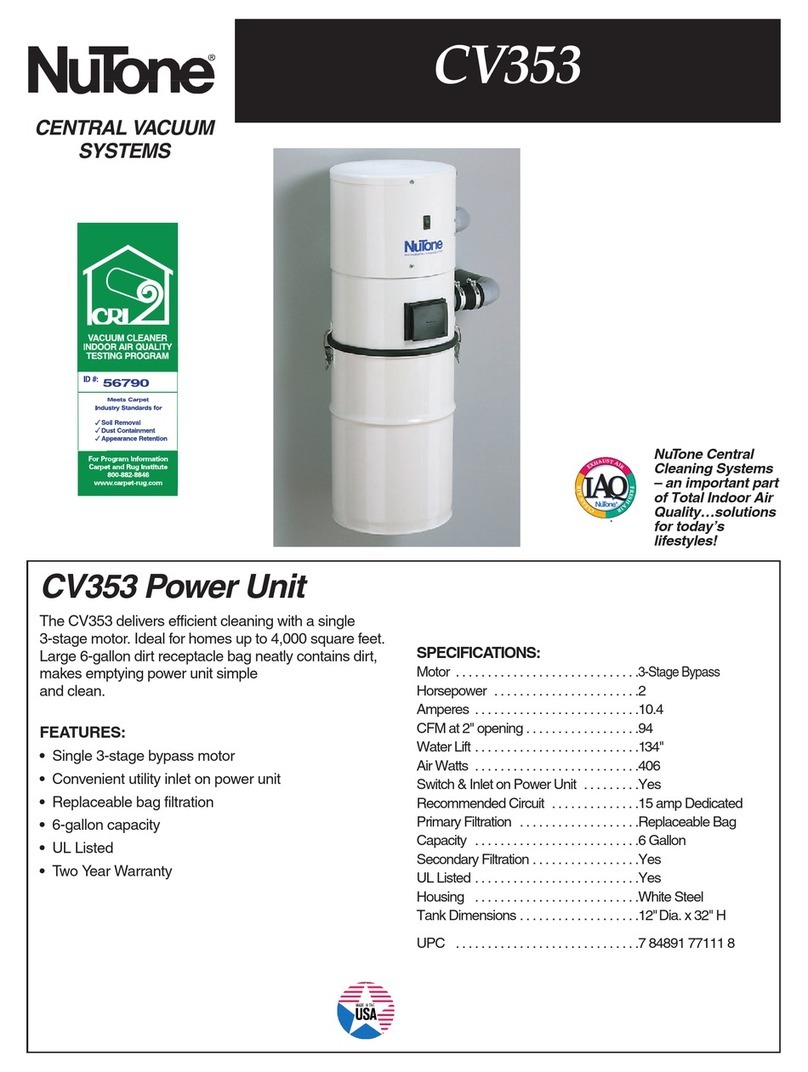
NuTone
NuTone CV353 User manual
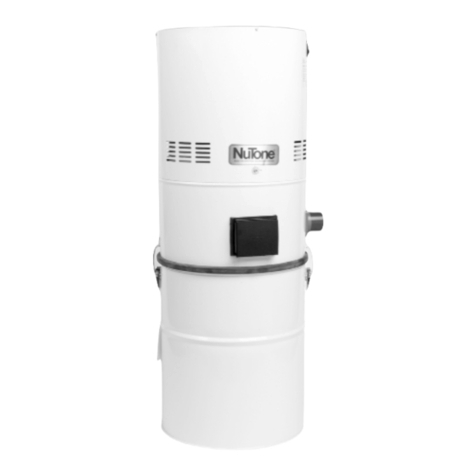
NuTone
NuTone CV450 User manual
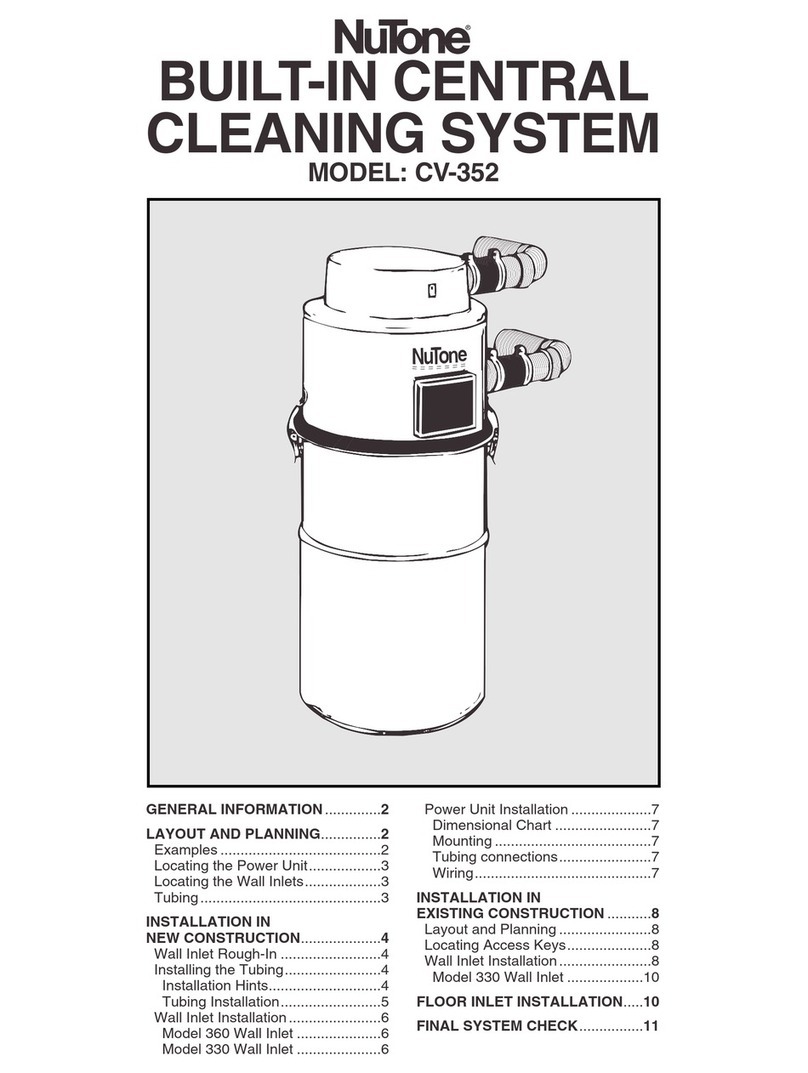
NuTone
NuTone CV-352 User manual
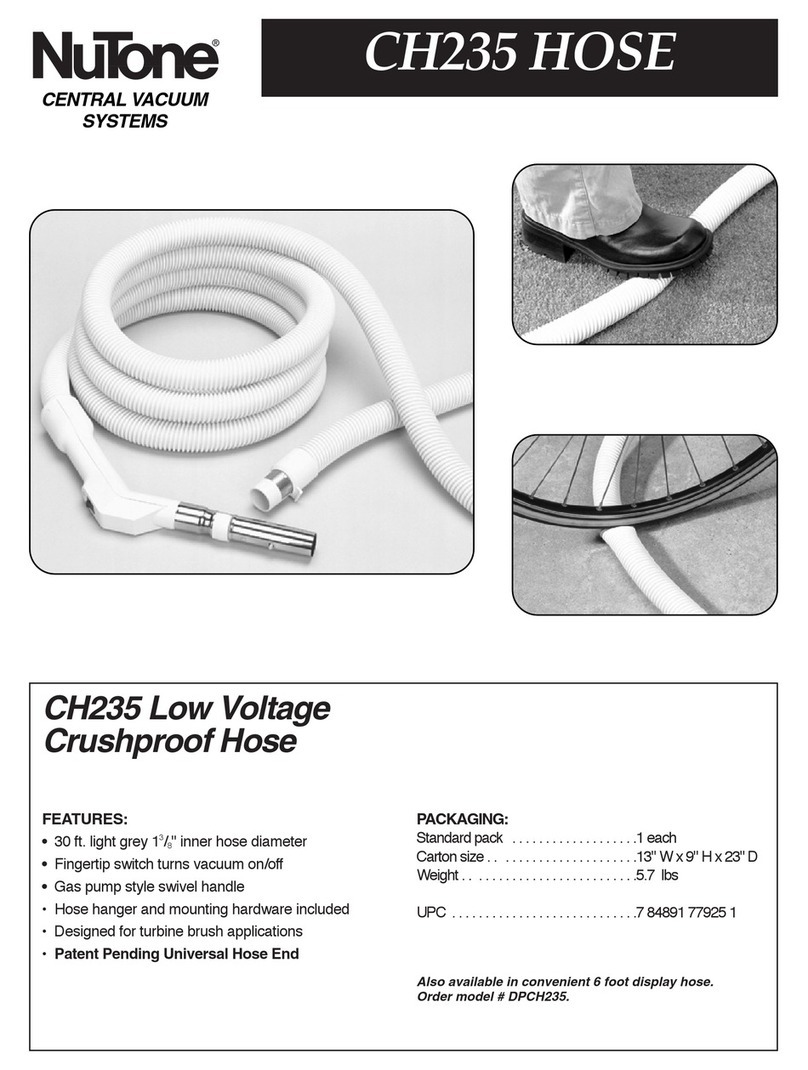
NuTone
NuTone CH235 HOSE User manual
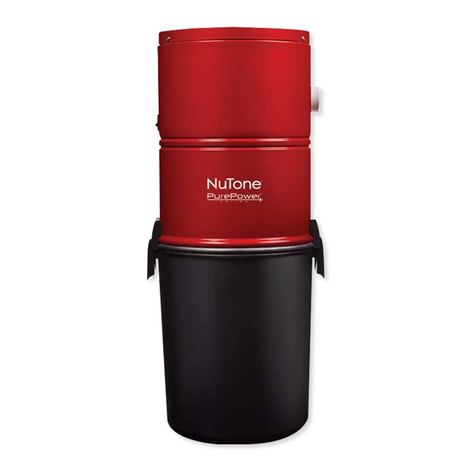
NuTone
NuTone PP5501 User manual
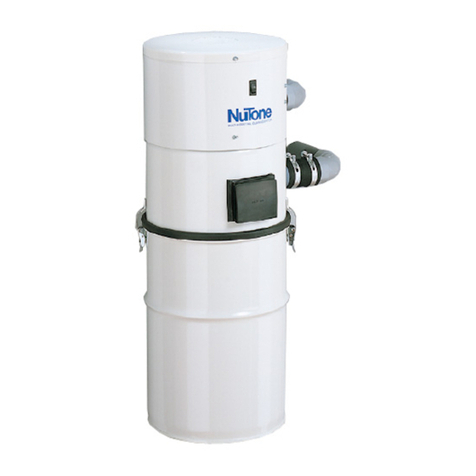
NuTone
NuTone CV353 Operating instructions

NuTone
NuTone CV554 User manual
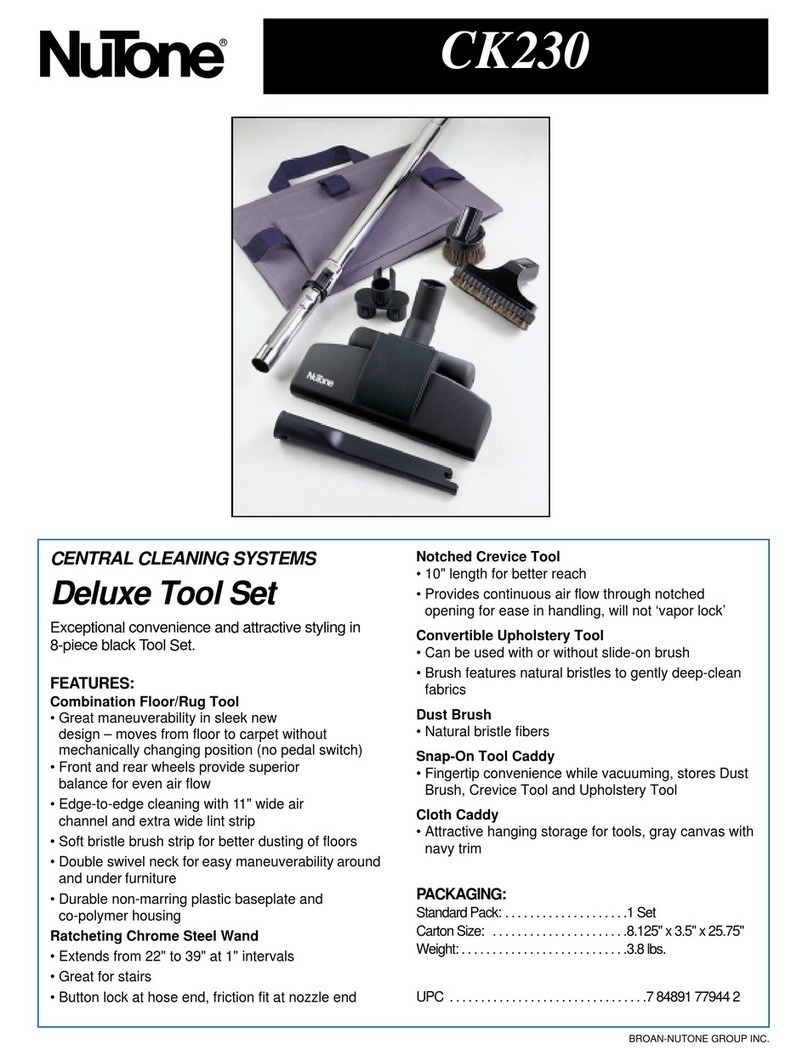
NuTone
NuTone CK230 User manual
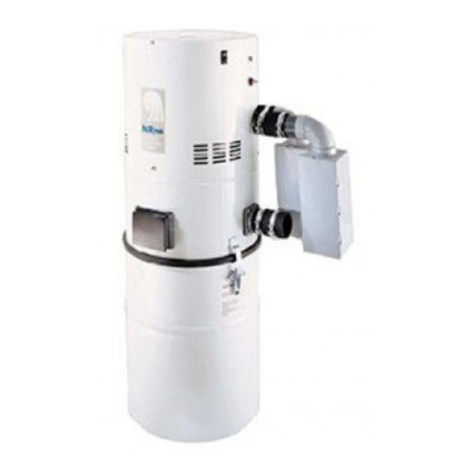
NuTone
NuTone Advantage CV850 User manual
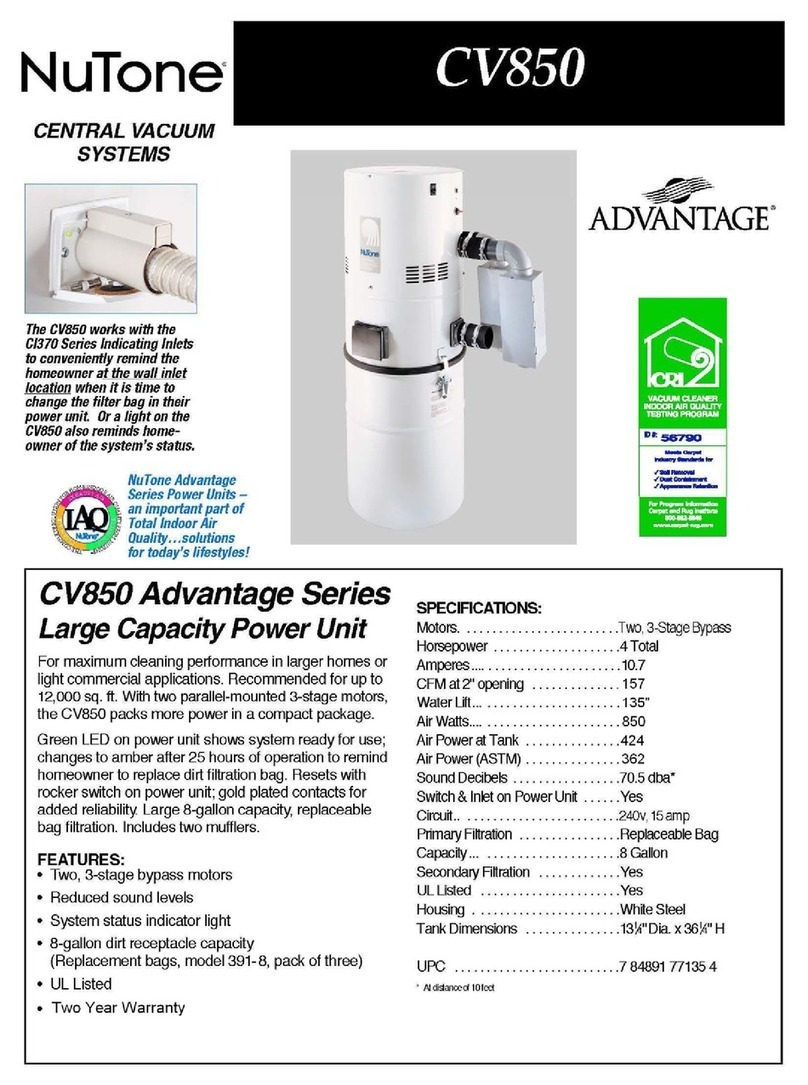
NuTone
NuTone Advantage CV850 User manual




